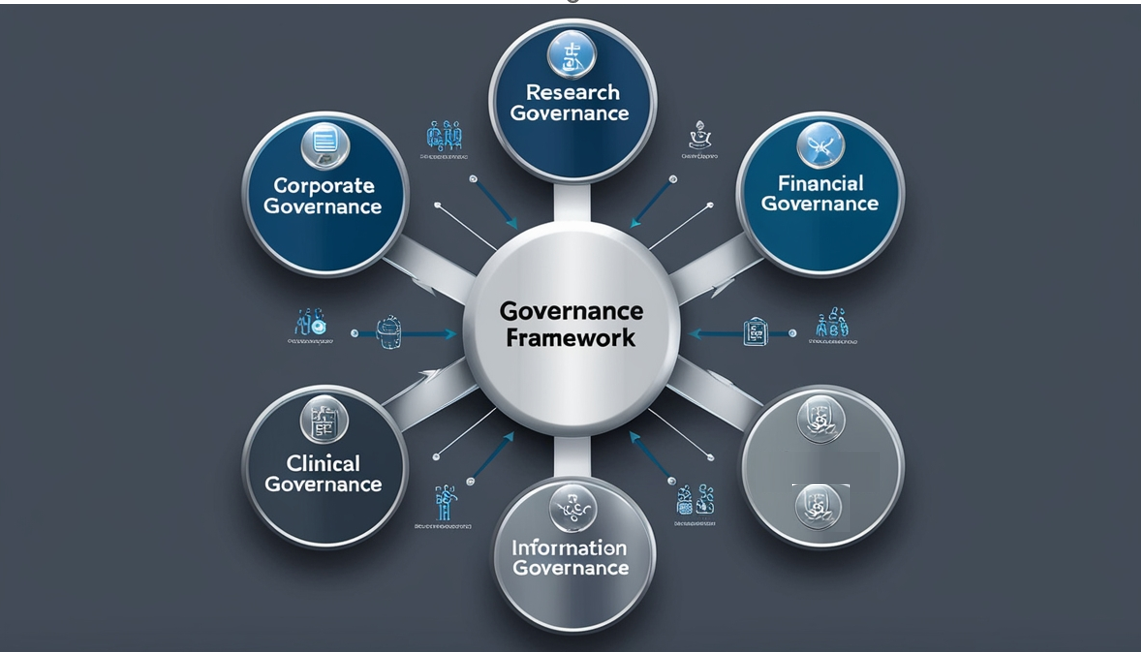Effective governance is the backbone of any successful organization. It ensures that the right structures, policies, and processes are in place to drive accountability, manage risks, and ensure resources are used effectively. This framework provides a detailed guide on the five essential areas that organizations must focus on to achieve information technology governance excellence: corporate, financial, clinical, information, and research governance. By following this five dimensional IT governance framework, organizations can streamline operations, enhance transparency, and consistently meet regulatory requirements.
In recent years, organizations have faced growing pressure to strengthen their governance structures. Stakeholders, including the public and regulatory bodies, demand greater transparency, accountability, and effectiveness in managing resources and ensuring quality services. This has been exacerbated by high-profile governance failures in various sectors, which have highlighted the need for more robust governance frameworks. The comprehensive five dimensional governance framework provides a structured approach to addressing these challenges by covering essential areas, such as corporate strategy, risk management, and performance monitoring.
Despite the importance of governance, many organizations struggle to implement a cohesive governance structure. Inconsistent practices, fragmented processes, and unclear accountability lines are common issues. Corporate governance often lacks alignment with financial oversight, clinical governance is siloed from broader operational objectives, and information governance is not given the priority it deserves. This fragmentation can lead to inefficiencies, operational risks, and poor decision-making, ultimately affecting service quality and financial performance.
When governance is poorly managed, the impact can be far-reaching. Financial mismanagement can drain resources, clinical oversight failures can jeopardize patient safety, and a lack of information governance can lead to significant data breaches. These issues not only damage an organization's reputation but can also lead to legal penalties, loss of stakeholder trust, and long-term operational difficulties. Furthermore, the growing complexity of modern organizations and regulatory environments means that governance failures can no longer be easily contained or rectified without significant disruption.
This five dimensional IT governance framework offers a practical and actionable solution. By integrating corporate, financial, clinical, information, and research governance into a single cohesive strategy, organizations can ensure that all areas of governance are aligned. This framework emphasizes risk management, accountability, and continuous quality improvement, providing organizations with clear guidelines on how to monitor performance, manage resources, and mitigate risks effectively. It promotes the use of risk registers, performance indicators, and structured governance committees to ensure that every aspect of governance is addressed in a systematic and consistent manner.
Main Contents
- The framework outlines five critical areas: corporate, financial, clinical, information, and research governance.
- Detailed guidance on implementing risk management strategies to safeguard resources and ensure accountability.
- Instructions for establishing structured governance committees to oversee each governance area.
- Strategies for monitoring performance through risk registers and key performance indicators.
- The framework emphasizes continuous improvement in governance through quality assurance and best practices.
Key Takeaways
- Organizations must integrate governance across corporate, financial, clinical, information, and research areas.
- Effective risk management is crucial for safeguarding resources and ensuring transparent operations.
- Structured governance committees play a pivotal role in overseeing risk management and performance.
- Monitoring performance through risk registers and indicators helps mitigate risks and improve decision-making.
- Continuous quality improvement is key to maintaining governance excellence and achieving organizational success.
By focusing on the five essential areas of governance, this framework ensures that CIOs and IT leaders can operate efficiently, safeguard the resources of their organizations, and maintain high standards of service delivery. Organizations that adopt this framework can expect to see improved accountability, better risk management, and more effective decision-making processes, ultimately leading to enhanced operational performance and stakeholder confidence.
CIOs can address common governance challenges and improve overall IT performance using this five dimensional IT governance framework:
- Align IT Governance with Corporate Strategy: CIOs can use this framework to ensure that IT governance is integrated with broader corporate goals, aligning IT resources and initiatives with the organization’s strategic objectives.
- Enhance Risk Management in IT Projects: The framework provides a structure for managing risk in IT projects by incorporating risk registers and performance indicators, helping CIOs identify and mitigate potential risks early in the project lifecycle.
- Strengthen Information Governance and Security: IT leaders can apply the guidelines from this framework to manage and secure information more effectively, ensuring compliance with data protection regulations and reducing the risk of data breaches.
- Improve Accountability through Structured Oversight: CIOs can implement governance committees focused on IT operations, ensuring clear accountability and enhancing decision-making processes across IT functions.
- Drive Continuous Improvement in IT Performance: By adopting a quality assurance mindset as outlined in the framework, CIOs can foster a culture of continuous improvement, regularly assessing IT performance and making necessary adjustments to meet evolving business needs.

